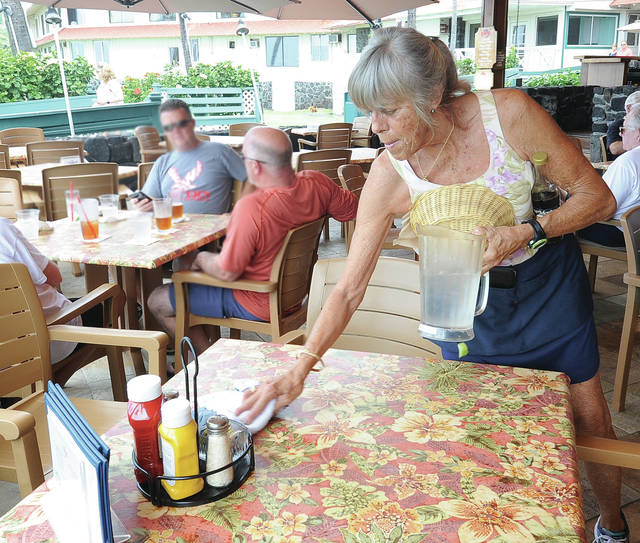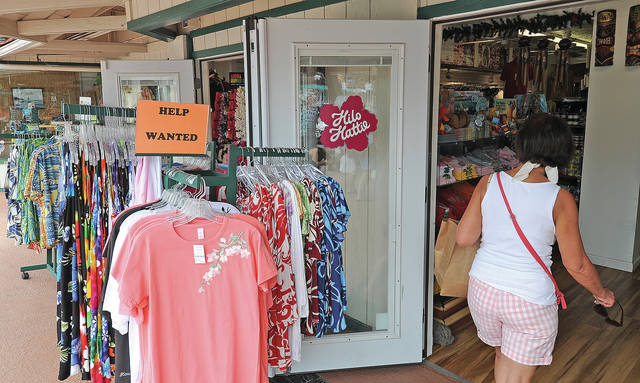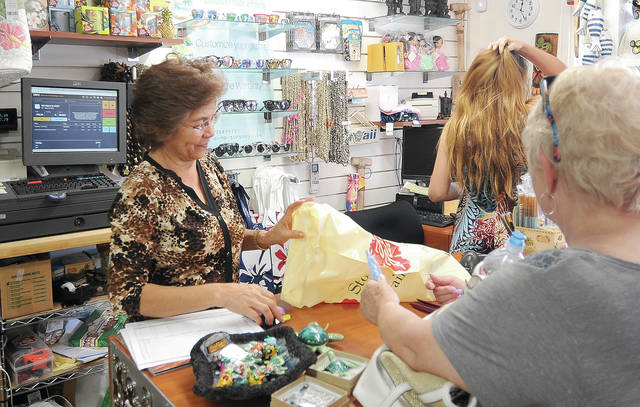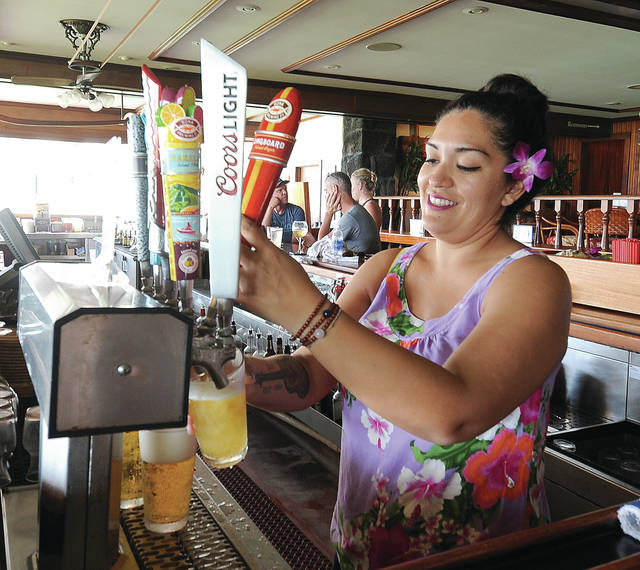KAILUA-KONA — Hawaii has not only its tropical beauty to boast about, but also the nation’s lowest unemployment rate at 2.1 percent.
Even so, there are drawbacks to this seemingly rosy situation.
A recently released report for the first 2018 quarterly report from Hawaii’s Department of Businesses, Economic Development and Tourism (DBEDT), showed the Big Island’s unemployment rate has been steadily declining since 2009, when joblessness during the recession reached 10.2 percent.
In 2017, the annual unemployment rate hit 3 percent, the lowest point in 18 years on Hawaii Island.
But an Associated Press story pointed out that employers statewide are finding it difficult to find and keep qualified employees in such a bull market.
Several West Hawaii businesses said last week they’ve experienced similar hiring headaches here on the leeward side.
“Last year sometime, there seemed to be help wanted signs sprouting up all over,” said Dennis Boyd, director of West Hawaii’s Small Business Center, on the impact of last year’s unemployment drop. “You couldn’t go anywhere without seeing one.”
Hawaii is not alone in its falling unemployment. The U.S. is at a 17-year nationwide joblessness low of 4.1 percent.
Economists forecast a possible half point drop this year, which would bring the U.S. unemployment rate to a half-century low.
The Big Island difference
Despite a parallel trend of employment on the rise, many Hawaii island businesses note a striking difference between hiring here and on the mainland.
Teresa Echols is manager of the store Hilo Hattie at the Kona Inn Shopping Village. She moved to the Big Island from Texas in September, and already notices the effects of Hawaii’s low unemployment rate.
“I’ve been in management for a long time and this is the biggest obstacle I’ve ever had in finding people. It’s just, wow. And when you look around, everyone’s looking for help,” said Echols.
Echols said because she has trouble finding workers, she often keeps less-qualified employees for longer than she’d like.
“You think about the alternative of opening and closing everyday, so you’re letting things slide by more than you would on the mainland where it’s like, three strikes and you’re out,” she explained.
And still, Echols often compensates for the lack of help at Hilo Hattie by filling store shifts herself.
“Today and tomorrow I’m working 14 hours,” she said.
The diminishing unemployment rate presents all Big Island businesses — from retail to restaurants — with an array of hiring issues.
Derek Nelson, manager of The Kona Inn Restaurant, specifically experiences difficulty hiring young people.
“We have two restaurants here in Kona and two in Southern California and Orange County so I came from there, and there’s a big difference there,” Nelson said.
“When you have, for instance, a dishwasher position. Somebody leaves and you have to fill that position, there’s like probably 10 guys who would call (in California). Here? Nobody between the ages of 17 and 24 really wants to work. We have a hard time filling busser positions, hosts, all the people you’d normally consider a young people’s position,” he added.
Boyd said a generational difference may be prompting the problem.
“It’s a generational thing, how millennials are in it for the experience … jobs at that level are so easy to find. If there’s one little thing that annoys somebody they could say, ‘Screw this. I could get this pay or better down the street,” explained Boyd.
And the turnover rate is very high in West Hawaii, according to Boyd as well as Echols.
“What I see from a lot of applicants is a lot of job experience one month here, two months there, it’s like they can’t keep a job … I don’t know if it’s because they don’t like the job,” observed Echols.
Though Nelson did not have trouble hiring for qualified jobs on the mainland, he does in Hawaii.
To problem-solve, Nelson hires in-house employees for advanced positions.
“Once you have a good dishwasher, once you replace them, you usually move people up within the ranks, which we prefer to do anyways. I’d much rather take somebody that’s already been on staff, that’s already put in time and trust,” he said.
The other side
of the coin
Luckily for local businesses, Boyd believes there are ways to combat consequences of Hawaii’s low employment rate.
“Do what you can to promote job satisfaction,” suggested Boyd. “Be nicer … make it easy for people to work there.”
He suggested both regularizing schedules and listening to employees’ concerns.
Speaking of employees’ concerns, workers from Royal Kona Resort gave an earful of them Wednesday afternoon.
Employees gathered to rally for quality jobs across the Big Island. They shouted, “No justice! No peace! No co-contract! No peace!”
The workers’ contract expired over a year ago, making them ineligible for wage and benefit hikes until a new contract is established.
Negotiations between Royal Kona Resort and union, Local 5, have been underway for over a year.
Despite the rally at the hotel and the state’s low unemployment rate, Jay Rubenstein, general manager of the Royal Kona Resort, said it has retained employees quite well.
“We have minimized the impact of the low unemployment rate by working hard to retain our staff. We are proud to have nine veteran employees with over 45 years of service at the property,” Rubenstein wrote in an email to West Hawaii Today.
Wendy Laros, executive director of the Kona-Kohala Chamber of Commerce, believes that work housing will help businesses to retain employees.
“We need to have affordable work housing,” she said.
Ross Birch, executive director of Island of Hawaii Visitors Bureau, agrees that the focus should be on providing employees with economical accommodation.
“Many of the positions at the hotels are entry level positions,” Birch said.
And many of these service jobs don’t pay enough to cover the state’s high housing costs.
According to the U.S. Census Bureau, 47 percent of Hawaii residents spend more than a third of their monthly income on rent, the greatest proportion put toward housing than any other state.
Around a quarter of renters put half of their income toward housing.
“Affordable housing is the way to decrease (the cost of) living,” said Birch.
Birch said resorts are interested in giving workers’ affordable housing, though the county hasn’t taken up any work housing projects.
It’s not only affordable housing, but transportation that plays a critical role in hiring and keeping employees.
“The other part is we need to have a reliable transportation system to get to work,” said Laros.
Laros added that The Kona-Kohala Chamber of Commerce has been working on making reliable transportation a reality for workers here.
A booming economy
Laros also highlighted the positive side of Hawaii’s low unemployment rate.
“That’s the result of being successful. The economy is getting stronger, and that’s a good thing,” she said.
And the tourism business is certainly doing well. There were 1,762,914 arrivals to the Big Island via plane in 2017 alone, a 13 percent climb from 2016’s 1,549,943 arrivals.
2017’s annual hotel occupancy rate rose to its highest in 18 years at 74.4 percent.
“There’s good opportunity for people who live here when there are actually good jobs to find,” said Laros.
Hidden Repercussions
Even with jobs galore, the state of Hawaii faces particular economic challenges.
Eugene Tian, Hawaii’s chief economist, said with Hawaii’s low unemployment rate, the state’s economy should be growing around 3 percent per year.
But it is only growing at 1.5 percent.
“We don’t have enough housing. We don’t have enough trained labor. That’s limiting the growth … they’re connected,” Tian said in a recent article by ABC News.
Paul Brewbaker, an economist with consulting firm TZ Economics, said Hawaii’s economy has grown just 1.6 percent compared to the national average of 2.1 percent since 2009.
On a per-capita basis, gross domestic product in Hawaii was one-third higher than the national average 40 years ago. Now the gross domestic product is same as the U.S. average.
Should the trend continue, there could be long-term economic consequences statewide.











Shouldn’t the response in a shortage of a item make that item worth more?
Wait, wait, wait!
We need a goberment group to “investigate” this!
After all, the
….once hired, can’t be fired,
folk have an in-law that needs a job….
and they are the “great Oz”!
They know now to bludgeon the businesses to be “better”!
This doesn’t add up. We have a huge homeless crisis and Harry Kim is spending millions of tax payer money on them and we can’t fill vacancies like washing dishes? Harry Kim will raise taxes to take care of them, his answer to everything.
you are spot on Scooby. Why work when you can get everything for free?
well said!!!!!!!!!!!!!!!!!!!!!!!!!!
Let’s see…too many people in Hawaii county on welfare, disability or ? That is why the rate is so low. Lots of folks are just too damn lazy to work. Even at 25$ an hour, they can’t be bothered to learn anything and if they are laid off, they cant wait to get unemployment. A favorite line is…”that’s not a job if you have to learn something, that would be a career and I am not interested”. Fabulous. Amazing so many people used to figure out how to get to work without reliable public transportation in the past. Sounds like a lot of whining. The homeless? Yes, 50% of them are lazy druggies, too.
glad to see your elf hat is on nice and tight…
Every time I’m at stores now I see healthy looking 18 to 25 year olds using EBT cards. Must be nice. While I head to work to starve.
Of that two percent unemployed, most are either unfit because of some psychological problem, drug problem or health disability or they simply would rather not work and collect whatever public assistance they can qualify to receive. And the younger guys would rather live at home and go surf as they don’t have a work ethic. And panhandling pays a whole lot better than a minimum wage job, folks!